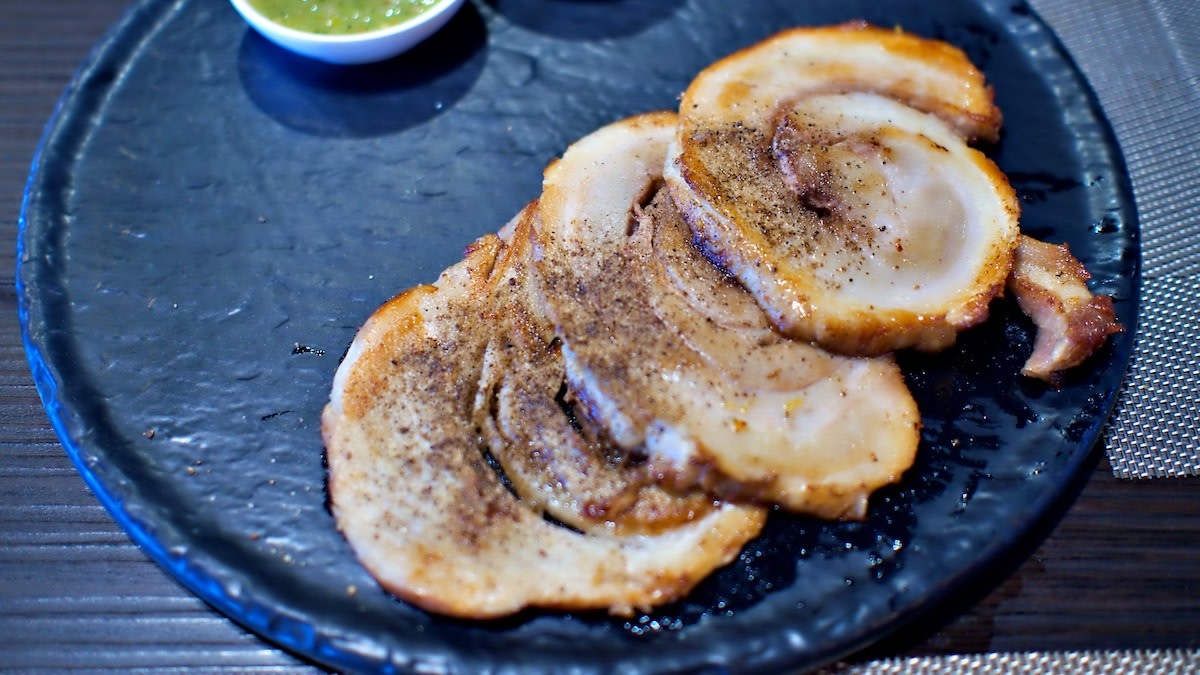Chashu Pork Recipe: Tips for Making and Serving Chashu
Written by MasterClass
Last updated: Jul 4, 2022 • 4 min read
Nothing soaks up hot ramen broth like a neatly spiraled slice of chashu, the tender Japanese braised pork belly set in a sweet and salty sauce.
Learn From the Best
What Is Chashu?
Chashu is a popular Japanese dish consisting of rolled pork belly braised in a sweet and salty liquid made from soy sauce, sake, sugar, and mirin, and aromatics like green onion, ginger, and garlic. To make Japanese chashu, chefs braise the pork belly over low heat for hours, roll and twine the protein, and then rest it overnight in braising liquid before searing and serving.
Chashu derives from char siu—Chinese barbecued pork—which chefs roast over high heat. Chashu is also occasionally referred to as “nibuta,” a Japanese word meaning “simmered pork.”
4 Tips For Making Chashu
If it’s your first time making homemade chashu, budget in more time than you think you’ll need to reduce the sauce. Additionally, leave time to rest the meat in the marinade as it will make a big difference in the final flavor. Here are some other tips to consider:
- 1. Choosing the pork: Pork belly is the traditional cut of meat that chefs and home cooks use to make chashu. The high fat content lends itself well to the low and slow cooking time and keeps the meat moist as it simmers. Pork shoulder will also work if you can’t find pork belly, though it will garner different results. If you’re cooking for a smaller crowd, use smaller blocks of pre-cut pork belly instead of a larger slab.
- 2. Rolling the pork: Rolling the pork into a tight scroll and securing it with butcher’s twine will help the meat reabsorb any moisture you may have rendered out during the cooking process, resulting in an especially tender texture.
- 3. Tying the pork with twine: Securing the pork belly with twine allows the meat to keep its spiralized log shape after cooking and resting, making for easy slicing. First, place the pork belly skin-side down in front of you, then roll it so that the cross-section that resembles a cut of bacon creates a spiral image on either side. Secure one end of the pork with butcher’s twine and double knot it. Run the twine down the length of the log, and secure the opposite end. Wrap the twine back to the starting side, with about a half-inch between each line. Secure the loose end and trim the excess twine.
- 4. Using the stovetop or oven: Combine the pork belly with braising liquid and any aromatics in a heavy-bottomed pot like a Dutch oven. Bring the ingredients to a boil on the stove, then reduce to a simmer and cook, partially covered, or place partially covered in an oven at 300 degrees Fahrenheit. In either approach, rotate the pork every thirty minutes to ensure even absorption of the marinade.
3 Ways to Serve Chashu in Japanese Cooking
In and outside Japan, chashu pork is at home in several classic dishes:
- 1. In a bowl of ramen: Slices of chashu are primarily known as a ramen topping for tonkotsu ramen, miso ramen, or shoyu ramen. The meltaway texture of the braised meat is an ideal pairing for the springy bite of fresh ramen noodles. (Plus, you can use the leftover marinade to make another favorite ramen topping, ajitsuke tamago—soft-boiled ramen eggs.)
- 2. On rice: In a simple chashu don, or rice bowl, sliced or diced chashu adds a sweet, salty, savory accent to steamed rice. Dice up leftover ends of a chashu pork roll and add it to fried rice dishes. Learn about the different types of donburi rice bowls.
- 3. Over noodles or a stir-fry: Serve chashu pork on top of flavorful stir-fried noodle dishes like yakisoba.
Easy Chashu Recipe
makes
prep time
5 mintotal time
10 hr 25 mincook time
2 hr 20 minIngredients
- 1
Combine soy sauce, sake, mirin, sugar, water, scallions, ginger, and garlic in a large, heavy-bottomed pot like a Dutch oven. Whisk to dissolve the sugar, and bring the mixture to a simmer over medium heat.
- 2
While the braising liquid warms, heat the oil in a large skillet over high heat and sear the pork belly. Use tongs to ensure the surface is golden brown and crispy on all sides.
- 3
Carefully transfer the seared pork belly to the braising liquid, and bring it to a boil. Reduce the liquid to a simmer once more, and partially cover. Cook on low heat, turning the pork belly at regular intervals until the sauce has reduced and the meat is fork-tender, about 2 hours.
- 4
Let the pork belly cool slightly, then transfer it to an airtight freezer bag. Strain the reduced sauce into a clean glass measuring cup. Add 1 cup of liquid to the bag, and reserve the rest for another use. Refrigerate the chashu overnight for at least 8 hours.
- 5
The next day, when you’re ready to serve the meal, remove the pork belly from the bag and cut away the twine. Slice into thin slices. To heat, use a blowtorch to sear the surface of the slices, place it briefly under a broiler, or warm it in a ¼ cup of sauce on the stovetop.
Become a better chef with the MasterClass Annual Membership. Gain access to exclusive video lessons taught by the world’s best, including Niki Nakayama, Gabriela Cámara, Chef Thomas Keller, Yotam Ottolenghi, Dominique Ansel, Gordon Ramsay, Alice Waters, and more.
